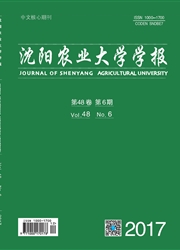

 中文摘要:
中文摘要:
2012 年对沈阳地区避雨和露地栽培条件下葡萄霜霉病自然发病情况进行了系统调查。对比分析表明:相同栽培条件下,不同品种间发病情况差异较大,无核白鸡心品种最早发病且流行程度最大,其次为红地球品种,巨峰品种发病最晚,发生程度最轻。应用SPSS11.5 进行回归分析,明确了Logistic 模型能够较好反映沈阳地区葡萄霜霉病流行时间动态情况,并推导了沈阳地区露地栽培条件葡萄霜霉病指数增长期为5 月1 日至7 月17 日,逻辑斯蒂增长期为7 月17日至8 月14 日,衰退期为8 月14 日以后;避雨栽培条件该病的指数增长期为5 月1 日至8 月14 日,逻辑斯蒂增长期为8 月14日至9 月11 日,衰退期为9 月11 日以后,明确了指数增长期为最佳药剂防治时间。避雨栽培可有效推迟葡萄霜霉病的始发期和衰退期,均可达到28d,并可显著降低该病的病情指数。同一栽培条件,不同品种间葡萄霜霉病增长速率存在一定差异;避雨栽培条件下,该病平均病病情指数最高增长速率 2.0871·d^-1,明显低于露地栽培条件下的增长速率4.5774·d^-1。相对湿度对该病病情扩展具有显著影响,田间湿度越大,病情扩展越迅速。
 英文摘要:
英文摘要:
Grape downy mildew was investigated under rain-shelter and open air cultivation conditions respectively in Shenyang area, 2012. There was great difference among the incidence investigation on tested grape varieties under the same cultivation condition by natural infection. The earliest incidence and highest disease index of grape downy mildew was Thompsons seedless, followed by Red-globe and Kyoho. Logistic model could well reflect the temporal dynamic of grape downy mildew under rain- shelter and open air cultivation conditions. Under open air cultivation, exponential phase was from May 1st to July 17th, logistic phase was from July 17th to August 14th. decline phase was after August 14th, Under rain-shelter cultivation, exponential phase was from May 1st to August 14th, logistic phase was from August 14th to September llth, decline phase was after September llth. Exponential phase was the most effective date for chemical control. Rain-shelter cultivation could significantly put off exponential phase and decline phase of grape downy mildew about 28d. The open air cultivation could also reduce disease index. The velocities of disease index on grape downy mildew were different among the tested grape varieties under the same cultivation condition. Average highest velocity under rain-shelter cultivation condition was 2.0871 ·d^-1, much lower than 4.5774·d^-1 under open air cultivation condition. Relative humidity had remarkable effect on the disease development, worse with higher humidity.
 同期刊论文项目
同期刊论文项目
 同项目期刊论文
同项目期刊论文
 期刊信息
期刊信息
